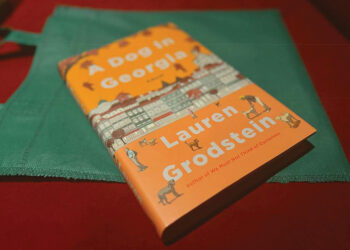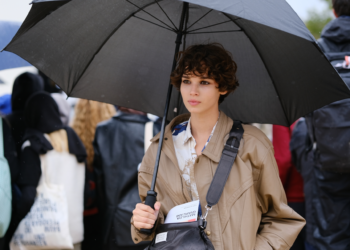The year 2024 has been a groundbreaking year for Reach Art Visual (R.A.V.), with Georgian art making waves on the international stage like never before. From powerful exhibitions to new collaborations, R.A.V. has played a key role in bringing Georgian artists into the global spotlight. We caught up with Founding Director Thea Goguadze-Apfel to reflect on the highlights of the past year and to hear what exciting plans are in store for the future of Georgian art.
What about last year in particular best demonstrated the growing international recognition of Georgian art?
2024 was exhilarating, and, frankly, a little surreal, to see Georgian art not just present but truly resonating in multiple international venues.
This year, our collaboration with the Art Foundation Anagi (AFA) marked a major milestone in archival research, cataloging over 5,000 artworks and uncovering the histories of 220 artists. Among them, Tbilisi-based painters Gregor Danelian and Alexei Balabouev emerged as pivotal figures. Both artists, of minority ethnic origins, reflect Tbilisi’s rich multicultural heritage and its vibrant art scene from the Soviet era.
Danelian’s work gained acclaim at Bonhams’ British and European Art auction in London, where his piece was a star lot, while Balabouev’s legacy was spotlighted at the Osenat International Auction in Paris and the Collin du Bocage auction in France. These events not only celebrated their artistry, but also introduced their overlooked contributions to a global audience, reinforcing the unique narratives of Georgian art.
In 2024, our participation in the Tbilisi Art Fair covered very meaningful collaborations. We collaborated with Vere Gallery to present a unique collection of Iliko Zautashvili’s works, and showcased Liu Kandareli Guangwen, whose series ‘Beyond Artistic Censorship’ had been largely unseen by the public and provided a deeply personal insight into the artist’s creative journey. In addition, in the framework of TAF, our partnership with Gallery FotoAtelier brought to light rare still-life photographs from the set of Sergei Parajanov’s Surami Fortress. These images, showcased during Parajanov’s 100th anniversary celebrations, offered an intimate glimpse into the creative process of this legendary filmmaker.
A big discovery this year was Merab Kopaleishvili, whose expressive paintings and papier-mâché sculptures blend Georgian cultural motifs with universal themes. His works debuted at the Tbilisi Art Fair and later reached ASIA NOW – Paris Asian Art Fair, in collaboration with Gallery 4710, symbolizing a new wave of Georgian art making its mark globally. Alongside Merab Kopaleishvili, acclaimed Georgian artists Tamar Nadiradze and Merab Gugunashvili were presented.
The Tbilisi Independent exhibition in London at Frieze No.9 Cork Street highlighted the summer. It brought together five Georgian galleries: E.A Shared Space, Gallery 4710, The Why Not Gallery, MAUDI, and CH64, including Reach Art Visual, to showcase artists like Lia Bagrationi and Alexandre Bandzeladze. The exhibition received high praise, with London based collector and art manager Bjorn Stern describing the works as dignified and quietly powerful. Collaborating on this project was a meaningful step in sharing the essence of Georgian art with a wider audience.
These moments are not just about individual successes, they’re about a collective shift. And it’s thrilling to be a part of it, to feel that momentum building. This is why initiatives like ZEGAVLENA (the first bilingual online magazine about Georgian Visual Art) are so close to my heart. It’s about creating a space for dialogue, for critical reflection, for documenting this very evolution that we’re witnessing.
What drives us at Reach Art Visual is this belief in the transformative power of art. It’s about connection, about dialogue, about creating spaces where structures and meaning flourish. Seeing Georgian art taking its place on the international stage is incredibly gratifying. It feels like we’re on the cusp of something special. It’s a privilege to be a part of this journey, to witness this unfolding, and to help, in our own way.

How is the international perception of Georgian art evolving, and what role has Reach Art Visual played in shaping this narrative?
There’s a palpable shift occurring, a distinct evolution in how the world is perceiving Georgian art. It’s moving beyond a niche interest, beyond the realm of the exotic or the undiscovered. We’re witnessing a growing appreciation for its unique DNA, for the particular blend of historical depth, cultural specificity, and contemporary dynamism that defines it. There is a recognition of a certain ‘dignity,’ as some have observed, a quiet intensity that permeates the work of many Georgian artists.
Tbilisi’s growing recognition as a regional art hub is reflected in its dynamic art scene and the increasing visibility of Georgian artists on the global stage. Events like the Tbilisi Art Fair and participation in major international platforms, including the Venice Biennale and the Chinese Biennale, highlight the caliber and unique perspectives of creative minds from Georgia. Additionally, initiatives like the Art & Travel International Film Festival underscore the broader cultural and economic impact of Georgian visual art.

But it’s not just about these big events. It’s about the conversations that are happening around Georgian art. There’s a genuine curiosity, an eagerness to understand the unique context from which this work emerges. Artists like Merab Kopaleishvili, who seamlessly blends mythological and tangible worlds, exemplify the unique approaches coming out of Georgia. And it’s not just about individual artists. Despite the tense political climate, the art scene in Georgia remains incredibly vibrant and responsive. Many exhibitions and initiatives reflect the current challenges and channel them into creative expression. For instance, Anna Dedabrishvili’s group exhibition ‘Qocrealism’ powerfully explored themes of identity and resilience, resonating deeply in these turbulent times. There is a strong sense of community here, and initiatives like the FEARLESS exhibition, a powerful response to the current challenges, demonstrate the resilience and solidarity within the art scene. It was inspiring to see so many galleries and artists come together, showcasing the unwavering commitment to art even in times of crisis. These types of events show the world that art is essential to us.
Reach Art Visual has always been driven by a desire to foster connections, to act as a bridge. We see ourselves as facilitators, creating platforms for these international conversations to occur. Our work on projects like Tbilisi Independent at Frieze, for instance, was about providing an opportunity for the unique voices of Georgian galleries and artists to be heard in a global context. Similarly, ZEGAVLENA magazine serves as a vital forum for documenting and analyzing these developments, fostering critical dialogue, and sharing these insights with a wider audience.
We’re not here to support a narrative in many ways where we could contribute, rather to help create the conditions for Georgian art to speak for itself, to be seen, to be understood on its own terms. And it’s incredibly gratifying to witness this growing appreciation, to see Georgian art taking its rightful place within the broader international art network.

On the current political crisis in Georgia – there is significant polarization, concerns about democratic backsliding, a strained relationship with our Western partners, and growing security threats both regionally and globally. How do these factors impact the art scene, and how does RAV navigate this complex environment?
This political upheaval and the ongoing dramatic developments cast a shadow over every aspect of our lives—not just the art scene in Georgia. The creative community, at the forefront of the protests, is facing some of its most difficult times. I am deeply shocked by what is happening. The future generation of Georgia is on the streets, and the country’s very future is at stake. To ignore this or attempt to violently suppress the anger and frustration of these people would be an unforgivable mistake—a betrayal of Georgia’s future.
This is precisely where art can have a powerful impact. In times of turmoil, it provides a vital space for dialogue, reflection, and resilience. At Reach Art Visual, we remain steadfast in our commitment to fostering an environment where artists can thrive and where their voices can be heard without fear.
While navigating this complex environment is undeniably challenging, we believe that by continuing our work—promoting Georgian art internationally and building bridges through culture—we can contribute to a more open and democratic Georgia, one that aligns with the European aspirations of its people.

Looking ahead, what are R.A.V.’s plans for 2025, and how do you envision continuing to build upon the momentum of 2024?
The energy surrounding Georgian art right now is undeniable, and building on the momentum of this past year is our driving force. For Reach Art Visual, 2025 will be about deepening our international collaborations. We are committed to forging stronger connections with galleries, institutions, and curators worldwide, creating more opportunities for Georgian artists to shine on a global stage. We will continue to advocate for Georgian art, share its unique stories, and ensure it resonates with ever-expanding audiences. Platforms like ZEGAVLENA will remain central to this mission, providing critical context and fostering meaningful dialogue within the art community. Additionally, we aim to expand our work on collaborative projects, creating more carefully curated moments where Georgian art can truly speak for itself.
Art Foundation Anagi is poised to make significant strides in 2025. While the full scope of its activities will be unveiled in due course, I can say that it’s all about creating a sustainable ecosystem for Georgian art, about nurturing talent from the ground up. AFA is set to become a significant pillar of stability and support for artists, researchers, and the entire art community. It’s about ensuring that the momentum we’ve seen in 2024 isn’t just a fleeting moment, but the beginning of a lasting legacy.
In 2025, we’re determined to continue fostering vital connections between Georgian art and the world, and to help Georgian art and artists achieve their European aspirations. The journey is ongoing, and the future is brimming with possibilities.
Interview by Team GT














